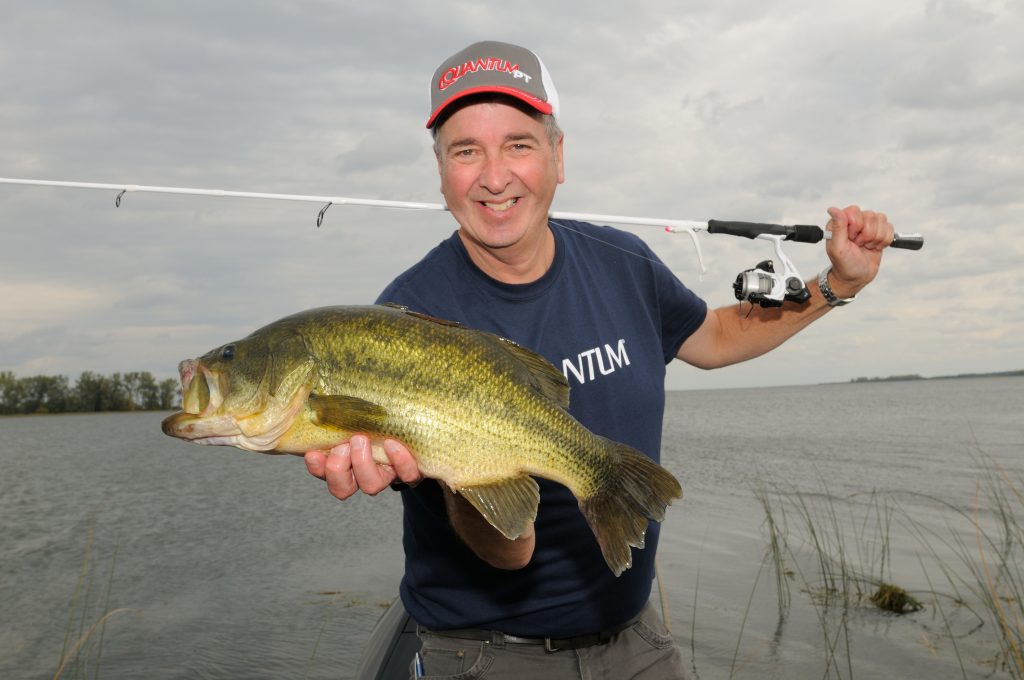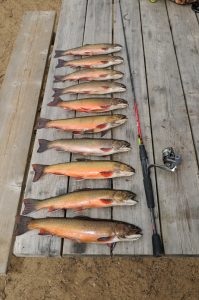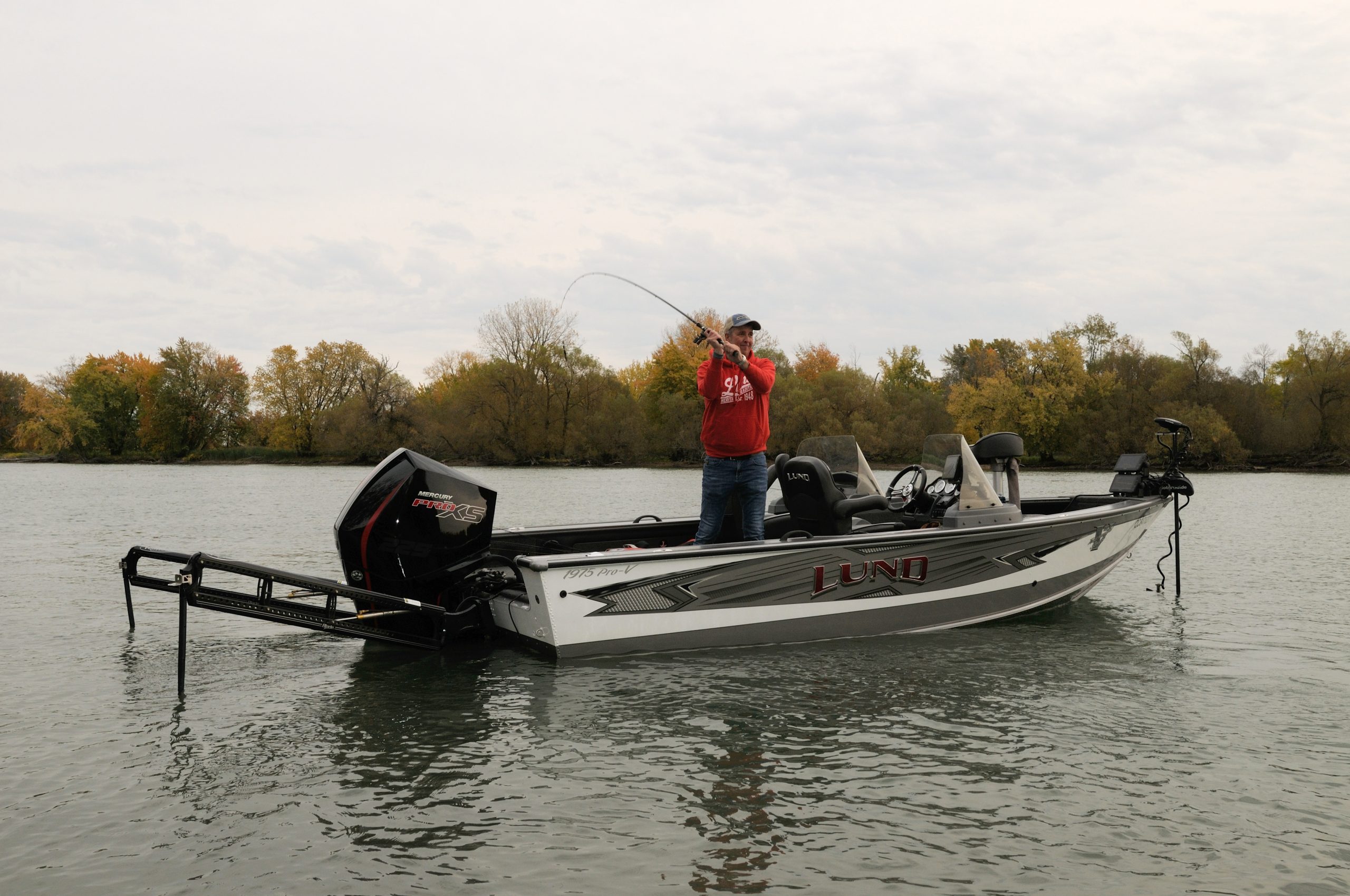By Patrick Campeau
Fishing is a bit like being a handyman, you need the right tools to do quality work.
When someone says that their fishing rod has too soft an action for a specific type of fishing, or that it is too short for a fishing technique or too stiff to use with small lures, it is obviously not going to get the job done in the most appropriate way. They may still catch their fish, but they will miss the enjoyment that comes when you choose the perfect combination of rod, reel, line, and lures.
You may ask how something that appears as simple as a line and a hook can become an elegantly complex combination of fishing tackle. This is the aura that surrounds sport fishing… a hobby and a pastime that millions of Canadians enjoy.
If you shop for fishing equipment without paying attention to the techniques and tackle appropriate for the fish you expect to encounter, and their environment, you will probably select the wrong gear. It is very important to identify specific needs in relation to the type of fishing being done, the techniques used, and the lures employed.

Selection Criteria
1 – The first questions that need to be answered are: What type of fishing will you be doing? What size fish do you expect to catch? Are you going to be casting, trolling, jigging, using a downrigger, or other methods?
2 – Will you use the reel for spinning, baitcasting, spin casting or trolling?
3 – What will be the approximate size of the lures you will use. (1/16 ounce, 3/8, 1/2, 3/4, etc.). On each rod there is an information label that lists the minimum and maximum weight of the lures that can be used to ensure optimal performance. Let’s say you opt for a rod that would work well with lures of 3/8 to 3/4 of an ounce.
If you use this rod with lighter (1/16, 1/8 or 1/4 ounce) lures, for example, you will have difficulty casting because the weight of the lure is too light to allow the rod to bend sufficiently to cast the lure in an energetic fashion. On the other hand, if your lure is too heavy – like 7/8 of an ounce or more, when you cast, the rod will be flexed to its maximum, and you will not achieve the optimum distance and accuracy.
4 – The breaking point of the fishing line you will be using is measured in pounds of resistance, often referred to as “test”. For super lines, such as P-Line XTCB Braid, you should refer to the resistance of the line and not to its diameter equivalent to monofilament. For example, if the rod designation indicates that the rod’s optimal parameters range from 8 lbs to 15 lbs of resistance, this tells you that lines under 8 lbs test may break under tension because the rod is possibly too stiff for use with such light tackle.
If you opt for 17, 20, or 25-pound test, which exceeds the recommended line rating for the rod, you will make shorter casts because there will be too much friction generated in the rod guides because of the diameter of the line. The rod could break if your fish exceeds the weight parameter of the line specified on the rod’s label.
5- Determine the type of action you would like to use. It is said that a rod can be as soft as a spaghetti noodle, or it can have medium action, or it can be as stiff as a baseball bat. There are a wide range of rods available. A parabolic or a light action rod is very soft. It will bend very easily during casts, and when you hook a fish, the rod will respond with a very light flex, providing a very sporting fishing experience.
It is important to know that the more flexible a rod is, the more it will allow you to use small lines because when it flexes it acts like a shock absorber. You will also be able to cast very small lures. However, it will be more difficult to make effective hooksets. During the setting motion, the rod will flex in a pronounced arc before transmitting the energy needed to set the hook.
There are the semi-medium flex rods that are halfway between the softer parabolic rods and the average rod. The medium-flex rods represent a good compromise in terms of hook setting action, the test of the line, and the weight of the lures they are designed to cast.
Rigid-action rods are a definite asset when it comes to angling for larger fish, as they transmit greater power when performing hooksets or casting larger lures. However, they are not suitable for using small lures and/or light line – it will break under the stiffness of the rod. Fortunately, rod manufacturers offer models with a semi-rigid action which often represent the best of both worlds, as well as extra-rigid models to meet the specific needs of certain techniques.
I have the pleasure of meeting a multitude of fishermen during the fishing shows I participate in and during my visits to the various fishing shops. You would be surprised to see how many people have no idea of how to test the action of a rod. More than 80% of people will bend the top section a few centimeters using their fingers to test out the action. Really, you can’t determine anything by doing this, but you risk breaking the tip of the rod.
The best method to check the flex of a rod is to grasp the handle firmly with one hand, raise the rod to the 11 o’clock position, and lower it very quickly and firmly to the 9 o’clock position where you will lock your hand.
The point of the rod will flex toward the ground, and you will be able to see how much it can bend, how fast it regains its original position, and how many “whips” it will make from top to bottom before it comes to a rest. Try this motion with a few different rods to compare the action and feel how sensitive the tip will be in a real fishing situation.
6 – What length of rod should you choose? In the shops, we find rods from 4’ 6” to 11’ 6”. The longest ones will normally be used for river rainbow trout fly fishing, downrigger fishing, or other specialized techniques.
The shorter rods are normally used for ultra-light fishing with very small lures and line in the 2 to 4 pounds test range. For jigging, most anglers prefer rod lengths of 5’ 9” inches or 6”, to be close to the action. For spinning, in general, rods in the 6 to 7-foot range are most often used.
7 – You must properly balance the outfit. It is important that the weight rating of the reel matches the capacity of the rod. A reel that is too big for a rod will cause it to tip backwards because of its excessive weight, and a reel that is too small for a rod will cause it to tilt forward. In that case, the point is too heavy.

The right rods for targeted species
Selection for speckled trout with small jigs and small spoons:
It is nice to be able to use a light-action rod that will allow you to cast small lures. For this category, for the casual angler, I don’t want to suggest an ultra-light rod of 4’ 6”, 5’ or 5’ 6” because they are very specialized, but if you have a budget that allows you to buy several rods, you may opt for one of these types and you will have a great time fishing the streams and small rivers.
For a more versatile product, I would lean toward a medium light action 6-foot two-piece rod. It will normally be soft enough to use small lines of 4 or 6-pound test, and small lures of about 1/16 ounce and a bit heavier.
I would also suggest some multi-purpose rods. I did not opt for an ultralight or light action rod because normally, they do not have enough power for some of the fish you may encounter, and these specialized rods lack versatility. A 6-foot multi-purpose rod with a medium-light action will be ideal for casting small jigs and small spinners and spoons.
It will allow you to very efficiently control the action of the lure in the water, you will be able to make good smooth hooksets, and you will enjoy the sensitivity of the rod as you control your fish as it fights the hook. Suggested products in this category include: The Quantum Throttle TH20602ML, Zebco Spyn20602M and Quantum Graphex 602M.
Selection for speckled trout and trolling for walleye:

When trolling for speckled trout, most of the time you will use a spoon with a scented leader and a worm, or a small grub. To tease the walleye, most fishermen troll a minnow bait behind their boats. Some will opt for worm harnesses with light sinkers. For these three techniques, you will need a rod that has enough body to absorb some of the action of the lure.
There is nothing more unpleasant than using a rod that bends under the effect of a swimming lure. At first, it always seems that it is about to break, then I wonder if it has enough power to allow me to set the hook. When a rod is very tight during trolling, it takes more effort from the fisherman to hold it in place. People commonly force these rods to keep them in place.
If the rod tension were released, it would launch into the air as if it were projected at arm’s length. The ideal trolling rod must have a sufficiently sensitive tip to allow you to clearly perceive the swimming movements of your lures.
A rod having an upper section that is too stiff will not allow you to sense that you just hooked some weeds, and this will not allow your minnow bait or spoon to operate correctly. A length of 6‘ is usually too short and 7’ is unnecessarily long, so I opted for a 6’ 6” rod.
In several situations it is easier to transport these rods, and they offer good versatility in terms of the line and the size of the lures you can use. Suggested products in this category include: The Quantum Throttle TH662M, Strategy SR30662M Zebco Stinger SSP662M, Equalizer EQLS662M and QX36 QXC36S662M.
Selection for Smallmouth Bass:
There are thousands of tackle options to thwart these combative fish, and almost as many techniques to land the lunkers. Although there are certain types of small lures that have been designed to tease bass, most lures preferred by pro fishermen are larger. Just think of spinnerbaits, tubes, surface lures, minnow baits, etc. While powerful, the Smallmouth Bass can take your tackle to places that are cluttered with obstacles that will break your line.
You must keep control over these pugilists and prevent them from taking your line and lure where they please – they will seek a place to hide when they feel trapped, and they are the masters of their underwater domain. A 6’ 6” or 6’ 8” rod with a medium-rigid action is the tool par excellence when it comes to teasing bass.
Offering the opportunity to use a wide range of lures and line weights, this type of rod will give you great service. Suggested products in this category include: The Smoke PT SMS684XF, Vapor VP684XK, Accurist ATS61052FA and the Throttle TH30662MH.
Selection for casting/trolling for pike and lake trout:
To combat these two fierce predators, you need a rigid, resistant, and especially versatile fishing rod. Pike love spoons and good-sized minnow baits. The angler will use them effectively while casting in bays and along escarpments behind the boat. For lake trout, when it comes time to tease them in the spring, just use spoons and minnow baits.
Later, in the season, it will be necessary to weight the lures a little, so they descend into the depths. It is obvious that during the warmer weather, you need specialized equipment that will allow you to go even deeper. A long, rigid two-piece rod of 6’ 10” inches or 7’ is recommended to confront these predators.
You can even, if you wish, use it with a downrigger. These rigid rods will flex like the specialized rods will, but they will get the job done. Don’t forget that you have a good chance of encountering a monster pike or a large lake trout. It is very important to be well equipped for this possibility. Suggested products in this category include: The Smoke SMS61052XF, Vapor VP6105XF, Accurist ATS7042XF and Graphex GXS702MH.

